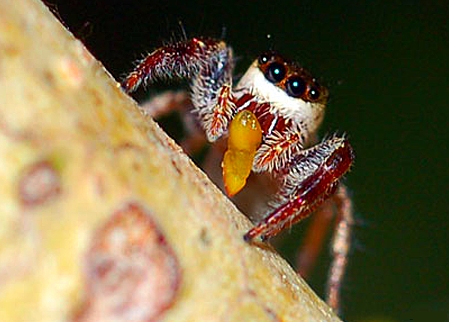Spider News
Hey, check out this little critter:

That's a species of spider called Bagheera kiplingi and it's a VEGETARIAN!!
It is a jumping spider that, instead of pouncing upon ants and consuming them, pounces on them and steals their food.
BBC news has this story featuring some actual cam footage of the spider in action.
US News has a more in depth article on how the whole relationship between the spider and the ants goes on.
Apparently the spider is not, as was originally thought, completely vegetarian. It occasionally snacks on an ant or larvae but its diet does seem mainly to be the acacia plants that the ants try to guard.
Also, I'd like to raise my hand as having been one of those who looked at the name of this spider and caught the reference. It was named after the friendly jaguar in Rudyard Kipling's Jungle Book, which I actually did read many years ago.
The Christian Science Monitor has this article talking about the spider but also talks about zombie spiders:
"The Bagheera kiplingi is cool. But in terms of arachnid news over the past decade, it’s No. 2 on my list.
The top of the list is more gruesome (you’ve been warned). Plesiometa Argyra is a fairly common fly and mosquito catching spider in Costa Rica. Every day of its life it weaves a flimsy circular web to catch its prey - unless it gets stung by a Hymenoepimecis argyraphaga wasp. That’s where this spider’s life gets, well, very interesting.
The wasp sting briefly paralyzes the spider and eventually turns it into a zombie.
The parasitic wasp lays an egg on the belly of the spider. When the spider awakes, it carries on as if nothing happened for a few weeks, even as the attached larva hatches and begins to feed on its blood. Then, when the larva has had its fill and is ready to cocoon, it takes over the mind of the spider by injecting it with chemicals that circumvent its web-building routine.
Rather than the circular, disposable web the spider has made every day of its life, it weaves a thick, highly simplified cocoon platform, then placidly settles down in the middle of it to allow the wasp larva to finish eating it. His meal finished, the larva spins its cocoon, suspended on sticky spider silk far from marauding ants or other creatures that might want to eat it, waiting to emerge as a wasp and begin the dance again."
Oh, and last but not least, while I was googling around to get more info about Bagheera kiplingi, I found this blog site which lists "The Top Ten Coolest Spiders", many of them very unusual. Good read if you can handle those close ups without getting creeped out.

That's a species of spider called Bagheera kiplingi and it's a VEGETARIAN!!
It is a jumping spider that, instead of pouncing upon ants and consuming them, pounces on them and steals their food.
BBC news has this story featuring some actual cam footage of the spider in action.
US News has a more in depth article on how the whole relationship between the spider and the ants goes on.
Apparently the spider is not, as was originally thought, completely vegetarian. It occasionally snacks on an ant or larvae but its diet does seem mainly to be the acacia plants that the ants try to guard.
Also, I'd like to raise my hand as having been one of those who looked at the name of this spider and caught the reference. It was named after the friendly jaguar in Rudyard Kipling's Jungle Book, which I actually did read many years ago.
The Christian Science Monitor has this article talking about the spider but also talks about zombie spiders:
"The Bagheera kiplingi is cool. But in terms of arachnid news over the past decade, it’s No. 2 on my list.
The top of the list is more gruesome (you’ve been warned). Plesiometa Argyra is a fairly common fly and mosquito catching spider in Costa Rica. Every day of its life it weaves a flimsy circular web to catch its prey - unless it gets stung by a Hymenoepimecis argyraphaga wasp. That’s where this spider’s life gets, well, very interesting.
The wasp sting briefly paralyzes the spider and eventually turns it into a zombie.
The parasitic wasp lays an egg on the belly of the spider. When the spider awakes, it carries on as if nothing happened for a few weeks, even as the attached larva hatches and begins to feed on its blood. Then, when the larva has had its fill and is ready to cocoon, it takes over the mind of the spider by injecting it with chemicals that circumvent its web-building routine.
Rather than the circular, disposable web the spider has made every day of its life, it weaves a thick, highly simplified cocoon platform, then placidly settles down in the middle of it to allow the wasp larva to finish eating it. His meal finished, the larva spins its cocoon, suspended on sticky spider silk far from marauding ants or other creatures that might want to eat it, waiting to emerge as a wasp and begin the dance again."
Oh, and last but not least, while I was googling around to get more info about Bagheera kiplingi, I found this blog site which lists "The Top Ten Coolest Spiders", many of them very unusual. Good read if you can handle those close ups without getting creeped out.